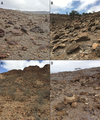Dosiero:Galegeeska habitat - Heritage et al 2020.png

Grandeco de ĉi antaŭvido: 499 × 599 rastrumeroj. Aliaj distingivoj: 200 × 240 rastrumeroj | 400 × 480 rastrumeroj | 640 × 768 rastrumeroj | 853 × 1 024 rastrumeroj | 1 619 × 1 943 rastrumeroj.
Fonta dosiero (1 619 × 1 943 rastrumeroj, dosiera grandeco: 6,82 MB, MIME-tipo: image/png)
Dosiera historio
Klaku daton/tempon por vidi la dosieron kia ĝi aspektis tiam.
| Dato/tempo | Bildeto | Dimensioj | Uzanto | Komento | |
|---|---|---|---|---|---|
| nuna | 10:41, 19 aŭg. 2020 |  | 1 619 × 1 943 (6,82 MB) | DagdaMor | {{Information |description ={{en|1=Somali Sengi (''Galegeeska revoili'', syn ''Elephantulus revoili'') habitat photographs from four localities in Djibouti. The Somali Sengi has been hypothesized as a rupicolous (petrophilic) species based on the collection coordinates of historic museum specimens which generally occur within the montane ecosystems of northern Somalia. However, whether or not the species is an obligate rock-dweller has not been documented. In Djibouti, all evidence of Somal... |
Dosiera uzado
La jena paĝo ligas al ĉi tiu dosiero:
Suma uzado de la dosiero
La jenaj aliaj vikioj utiligas ĉi tiun dosieron:
- Uzado en de.wikipedia.org